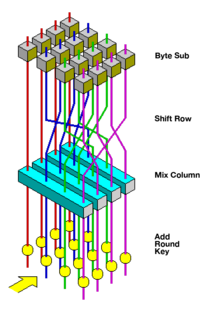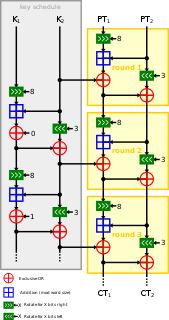Related Research Articles

The Advanced Encryption Standard (AES), also known by its original name Rijndael, is a specification for the encryption of electronic data established by the U.S. National Institute of Standards and Technology (NIST) in 2001.
In cryptography, a block cipher is a deterministic algorithm operating on fixed-length groups of bits, called blocks. They are specified elementary components in the design of many cryptographic protocols and are widely used to implement the encryption of large amounts of data, including data exchange protocols. It uses blocks as an unvarying transformation.

The Data Encryption Standard is a symmetric-key algorithm for the encryption of digital data. Although its short key length of 56 bits makes it too insecure for applications, it has been highly influential in the advancement of cryptography.
In computing, Internet Protocol Security (IPsec) is a secure network protocol suite that authenticates and encrypts the packets of data to provide secure encrypted communication between two computers over an Internet Protocol network. It is used in virtual private networks (VPNs).
A5/1 is a stream cipher used to provide over-the-air communication privacy in the GSM cellular telephone standard. It is one of several implementations of the A5 security protocol. It was initially kept secret, but became public knowledge through leaks and reverse engineering. A number of serious weaknesses in the cipher have been identified.

The Clipper chip was a chipset that was developed and promoted by the United States National Security Agency (NSA) as an encryption device that secured "voice and data messages" with a built-in backdoor that was intended to "allow Federal, State, and local law enforcement officials the ability to decode intercepted voice and data transmissions." It was intended to be adopted by telecommunications companies for voice transmission. Introduced in 1993, it was entirely defunct by 1996.
In cryptography, Skipjack is a block cipher—an algorithm for encryption—developed by the U.S. National Security Agency (NSA). Initially classified, it was originally intended for use in the controversial Clipper chip. Subsequently, the algorithm was declassified.

STU-III is a family of secure telephones introduced in 1987 by the NSA for use by the United States government, its contractors, and its allies. STU-III desk units look much like typical office telephones, plug into a standard telephone wall jack and can make calls to any ordinary phone user. When a call is placed to another STU-III unit that is properly set up, one caller can ask the other to initiate secure transmission. They then press a button on their telephones and, after a 15-second delay, their call is encrypted to prevent eavesdropping. There are portable and militarized versions and most STU-IIIs contained an internal modem and RS-232 port for data and fax transmission. Vendors were AT&T, RCA and Motorola.
The National Security Agency took over responsibility for all U.S. Government encryption systems when it was formed in 1952. The technical details of most NSA-approved systems are still classified, but much more about its early systems have become known and its most modern systems share at least some features with commercial products.
The Secure Communications Interoperability Protocol (SCIP) is a US standard for secure voice and data communication, for circuit-switched one-to-one connections, not packet-switched networks. SCIP derived from the US Government Future Narrowband Digital Terminal (FNBDT) project. SCIP supports a number of different modes, including national and multinational modes which employ different cryptography. Many nations and industries develop SCIP devices to support the multinational and national modes of SCIP.
VINSON is a family of voice encryption devices used by U.S. and allied military and law enforcement, based on the NSA's classified Suite A SAVILLE encryption algorithm and 16 kbit/s CVSD audio compression. It replaces the Vietnam War-era NESTOR (KY-8/KY-28|28/KY-38|38) family.
BATON is a Type 1 block cipher in use since at least 1995 by the United States government to secure classified information.

Secure voice is a term in cryptography for the encryption of voice communication over a range of communication types such as radio, telephone or IP.
NSA Suite B Cryptography was a set of cryptographic algorithms promulgated by the National Security Agency as part of its Cryptographic Modernization Program. It was to serve as an interoperable cryptographic base for both unclassified information and most classified information.

A secure telephone is a telephone that provides voice security in the form of end-to-end encryption for the telephone call, and in some cases also the mutual authentication of the call parties, protecting them against a man-in-the-middle attack. Concerns about massive growth of telephone tapping incidents led to growing demand for secure telephones.
CYPRIS was a cryptographic processor developed by the Lockheed Martin Advanced Technology Laboratories. The device was designed to implement NSA encryption algorithms and had a similar intent to the AIM and Sierra crypto modules. However, the principal references date back to the late 1990s and it does not appear that the CYPRIS ever earned NSA's Type 1 certification, without which it could not be used to protect classified government traffic.

BitLocker is a full volume encryption feature included with Microsoft Windows versions starting with Windows Vista. It is designed to protect data by providing encryption for entire volumes. By default, it uses the AES encryption algorithm in cipher block chaining (CBC) or XTS mode with a 128-bit or 256-bit key. CBC is not used over the whole disk; it is applied to each individual sector.

Cryptography, or cryptology, is the practice and study of techniques for secure communication in the presence of adversarial behavior. More generally, cryptography is about constructing and analyzing protocols that prevent third parties or the public from reading private messages; various aspects in information security such as data confidentiality, data integrity, authentication, and non-repudiation are central to modern cryptography. Modern cryptography exists at the intersection of the disciplines of mathematics, computer science, electrical engineering, communication science, and physics. Applications of cryptography include electronic commerce, chip-based payment cards, digital currencies, computer passwords, and military communications.

Speck is a family of lightweight block ciphers publicly released by the National Security Agency (NSA) in June 2013. Speck has been optimized for performance in software implementations, while its sister algorithm, Simon, has been optimized for hardware implementations. Speck is an add–rotate–xor (ARX) cipher.

Bullrun is a clandestine, highly classified program to crack encryption of online communications and data, which is run by the United States National Security Agency (NSA). The British Government Communications Headquarters (GCHQ) has a similar program codenamed Edgehill. According to the BULLRUN classification guide published by The Guardian, the program uses multiple methods including computer network exploitation, interdiction, industry relationships, collaboration with other intelligence community entities, and advanced mathematical techniques.